May 3, 2010
Checking out the very new and very old
Walkway Over The Hudson State Historic Park
The Wife and I finally made it down to check out the Walkway Over The Hudson State Park, which opened this past October 2009 for the first time. It’s about an hour and twenty minutes driving south from Albany, located just north of the Mid-Hudson Bridge.
Almost the entire park consists of a pedestrian walkway built on top of an 1889 railroad trestle that spans the Hudson River. At 212 feet above the river it is currently the highest pedestrian walkway in the entire world. The Hudson is about half a mile wide at this point, so including the high up in the air landward approaches, maybe the entire park is a mile long.
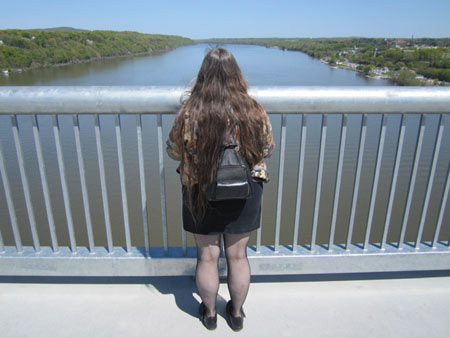 View From Mid-Walkway, Looking North Toward Albany
View From Mid-Walkway, Looking North Toward Albany
We had a hell of a time trying to find the entrance on the west side of the river. Since I hate to follow orders or directions, I didn’t bother to download a map. I know where to find the Mid-Hudson Bridge, so how hard could it be?
It turns out that there is absolutely no signage of any sort on the mostly uninhabited west side of the river. The entrance to the walkway turns out to be at the end of a small local road, you can’t possibly find it without precise directions. We could see the damn walkway like over there somewhere, but no way to get there by legally traveling on the blacktop.
So next thing you know I made a wrong turn and we found ourselves crossing the Mid-Hudson Bridge into the heart of downtown Poughkeepsie. Again, above the rooftops of the City we could see the entrance to the east side of the bridge like up over there. This time we careened around on the urban back streets until The Wife spotted some signs pointing in the right direction.
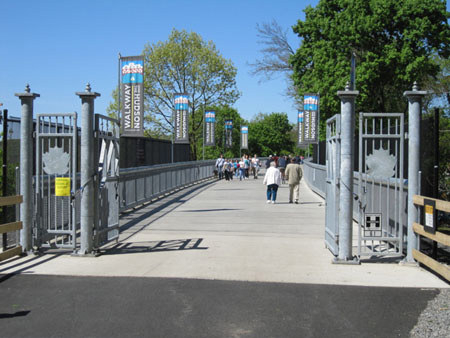 Gate On The Poughkeepsie Side
Gate On The Poughkeepsie Side
For future reference, if you can find the Poughkeepsie train station, it’s a short uphill walk to the entrance and parking lot of the walkway. Later I heard stories of people coming up from NY City for the day on the Metro North or the Amtrak to walk across the river. Presumably when they are through walking across the river these folks go looking for lunch or whatever else they can buy in downtown Poughkeepsie.
It’s a sad shame that our backward Albany City government officials cannot comprehend the importance of public transit to our local economy. Past Albany civic leaders sent our train station across the river to Rensselaer, our current Mayor Jerry Jennings wants to send our miserable little bus station over there too. We can’t even get a train link built that goes to the Rensselaer station, let alone extend the Metro North to Albany.
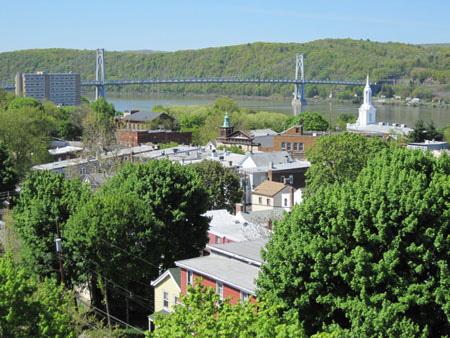 Rooftops Of Poughkeepsie, Between The Train Station And The Walkway
Rooftops Of Poughkeepsie, Between The Train Station And The Walkway
On the landward part of the walkway we could look down at the thriving Poughkeepsie neighborhoods around the train station. The railroad trestle had not been crossed by trains since a spectacular fire in 1974, so until last year it sat rotting above it all like a rusty hazardous spike pointing into the heart of downtown Poughkeepsie. This once magnificent iron structure, at one time the highest cantilevered bridge in the world, had become a very visible eyesore and safety hazard.
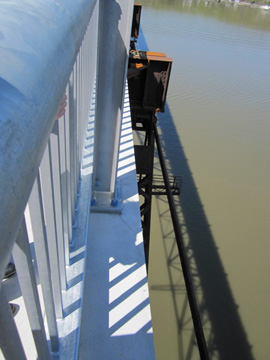 Leaning Over The Edge,Showing The Old Trestle Under The New Walkway
Leaning Over The Edge,Showing The Old Trestle Under The New Walkway
And yet, the neighborhoods between the train station and the south side of the new walkway appeared to be well kept and thriving. In contrast, the river front property on the north side of the walkway was typical burned out industrial, we could see the telltale round concrete slabs that once supported oil tanks. Probably now that the old rail bridge has become a focus of pride, we will see new urban neighborhoods built over this old tank yard… after it’s cleaned up.
From the entrance to the walkway, we noticed a clean up crew working right up next to the fence down below. It looked to me like the last of the neglected lots filled with junk, visible from the walkway but not from the ground. When the walkway was an abandoned rail trestle no one could see or care about all the crap piled up underneath, but no doubt the urban survivor who collected all that junk will find another piece of property that is out of public view.
The State of New York vastly underestimated the number of people who would use the walkway. The State expected 70 to 80 thousand people to use it during a typical year but according to volunteers that we met, well more than half a million have traversed the span since it opened last October! This according to the automatic counters installed at the gates, and the very visible fact that on a sunny day like this particular Saturday both parking lots on either end of the walkway appeared to be way much too small to accommodate the cars.
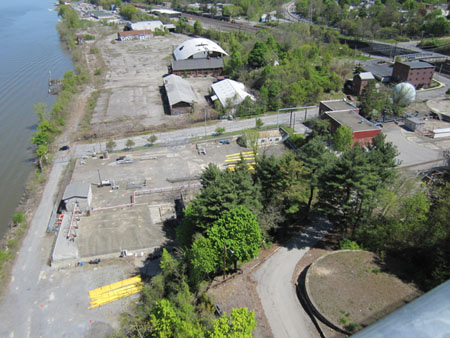 Industrial Burnout North Of The Poughkeepsie Entrance
Industrial Burnout North Of The Poughkeepsie Entrance
Despite all this, there are some who consider this renovation a waste of money. But consider this. The State had estimated the cost of taking down the rail trestle, which had turned into a serious attractive nuisance along with being an eyesore, to come in at $45 million. That’s big money to wreck a serviceable bridge.
It turned out to be cheaper to turn the bridge into a walkway than to take it down. The final cost for the conversion was $38.8 million, the State of New York spent $22.5 million, the Feds kicked in about $3.5 million. Most of the rest came from foundation grants, including a million from Scenic Hudson.
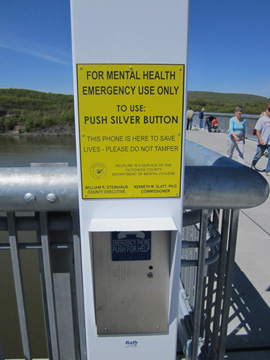 In Case Of Suicidal Tendencies
In Case Of Suicidal Tendencies
It should go without saying that our State officials didn’t come up with this idea that saves the taxpayers money and boosts the economy of the Hudson Valley. After all, reusing this walkway runs contrary to the principles of corporate socialism, it does not directly enhance some foreign corporation’s bottom line. Therefore, in the minds of most of our elected and appointed officials, if a project only benefits people and not a corporation it’s a waste of money.
It took years of organized work by local activists (they prefer to be called “volunteers”) to convince the politicians to plow some of our money back into the State for a change. The first group organized back in 1992 in response to the first proposal to wreck the bridge. The Wife and I encountered these original volunteers manning a table at a fair or flea market or something like that.
We talked quite a bit with them and we were very sympathetic to their cause, but it sounded hopeless to me at the time. For one thing, the guy we talked to told us that he planned to finance the walkway by selling the railway ties and tracks as, I guess, souvenirs. Clearly this first group of folks were full of enthusiasm but did not have a practical plan.
Around 1995 the group reorganized. Some of the old volunteers dropped out because of the funding issue, it seems that they were ideologically opposed to accepting government funding for the project. (I wonder if they would have accepted corporate money.) The new group was more practical, they realized such public projects don’t get done at all without government cooperation.
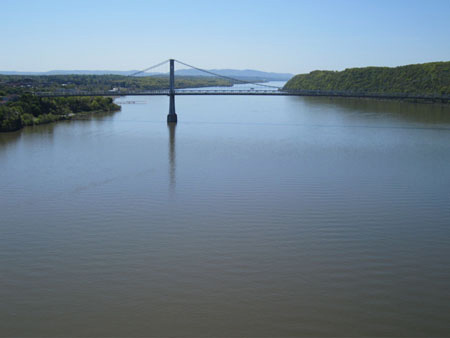 View South From Mid Walkway
View South From Mid Walkway
After that the ball got rolling. It probably helped that the bridge was a highly visible eyesore hanging above a populated urban center, an ugly beast hanging over everyone’s heads. It turned out that the volunteers, by calling for the rail bridge to become a walkway, were giving voice to an idea that had already half-formed in a lot of peoples’ minds. Why destroy this perfectly usable thing, this thing that is always in front of us and is a part of our lives? Why not find a new use for it?
So support for the project quickly became broad and popular in and around the City of Poughkeepsie. This gave the new group of volunteers the clout to begin leaning on the elected officials, who were beginning to see the popular walkway idea as a source of votes. Very rapidly the proposal went from crazy and hopeless to practical and inevitable.
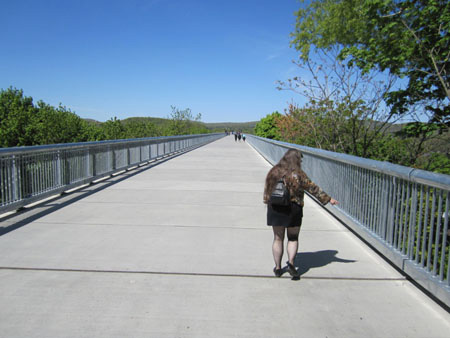 The Wife Points To The Joints Along The Rail
The Wife Points To The Joints Along The Rail
One of the objections to the proposal had to do with engineering, how can you put a stationary platform on top of a cantilevered bridge, which is designed to move? Won’t the added top surface crack and slough off when the iron structure underneath sways in the wind? As it turned out, there was a simple solution to this problem.
The walkway itself is a series of interlocking slabs of concrete that are connected together by movable joints. The rails on rails sides of the walkway are also jointed at short intervals, connected by a smaller tube bolted inside a larger outer tube. This simple design allows the rail to move ever so slightly and imperceptibly up and down and also left and right.
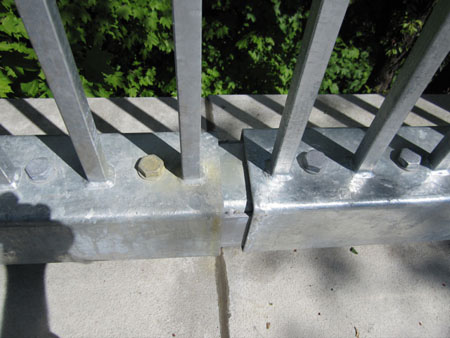 Joint At The Bottom Of The Raill
Joint At The Bottom Of The Raill
At this time there is absolutely no destination worth mentioning on the west side of the walkway, I expect that will change. The walkway is on track to host more than a million visitors in it’s first year of operation, such foot traffic is bound to raise real estate prices, particularly on the mostly uninhabited west side. We could have used some coffee after our grueling half mile stroll, but alas there wasn’t even an ice cream wagon to greet us.
The volunteers had a table on that end, it was great to talk to successful activists who had achieved their main goal. It gives one hope for the system in spite of overwhelming evidence to the contrary, apparently the corporations haven’t destroyed liberal democracy quite yet. The volunteers that we talked to were still full of enthusiasm for their baby.
One thing they told us is that an elevator will be constructed on the west side. I suppose this will meet handicapped requirements, but I haven’t the slightest idea why such a thing is needed or where it will go. Perhaps an elevator will allow construction of more parking lots downhill and will be used mostly by fat lazy people who can’t climb a short rise without feeling faint.
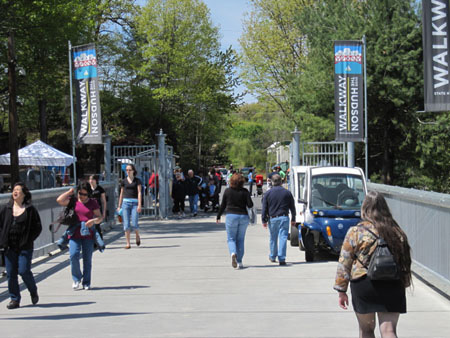 Approaching The Western End
Approaching The Western End
We arrived pretty early on a warm beautiful Saturday, so we missed the big crowds. We shared the bridge with a fair number of people, but we had plenty of space to move around and take pictures. The real hordes were only showing up as we were leaving in early afternoon.
When we walked back to the parking lot in Poughkeepsie, it looked like a major “special event” in progress. Our little paved parking lot, which was nearly full when we arrived was now guarded by a young lady wearing a safety vest. She was directing cars across the street to a big dirt lot, from what we could see that lot was nearly full.
Clearly a planning initiative is needed for both ends of the walkway, it would not benefit anyone to let the land around both ends descend into ugly sprawl. Now that the project is done, and more spectacularly successful than anyone expected, the new walkway will transform the nearby landscape. Whether that transformation is positive or harmful will depend upon the plans or lack of plans that will be put forth by the municipalities on either end.
No doubt this is the kind of problem the volunteers were hoping to achieve almost twenty years ago, back when a few kooks and nuts looked up at the rusty abandoned rail bridge and first imagined that it could be put to better use.
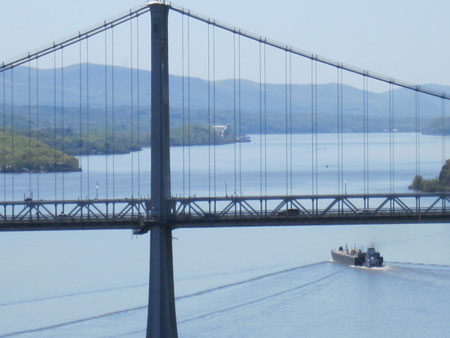 Tanker Under The Mid Hudson Bridge
Tanker Under The Mid Hudson Bridge
Prior Post * * * Next Post